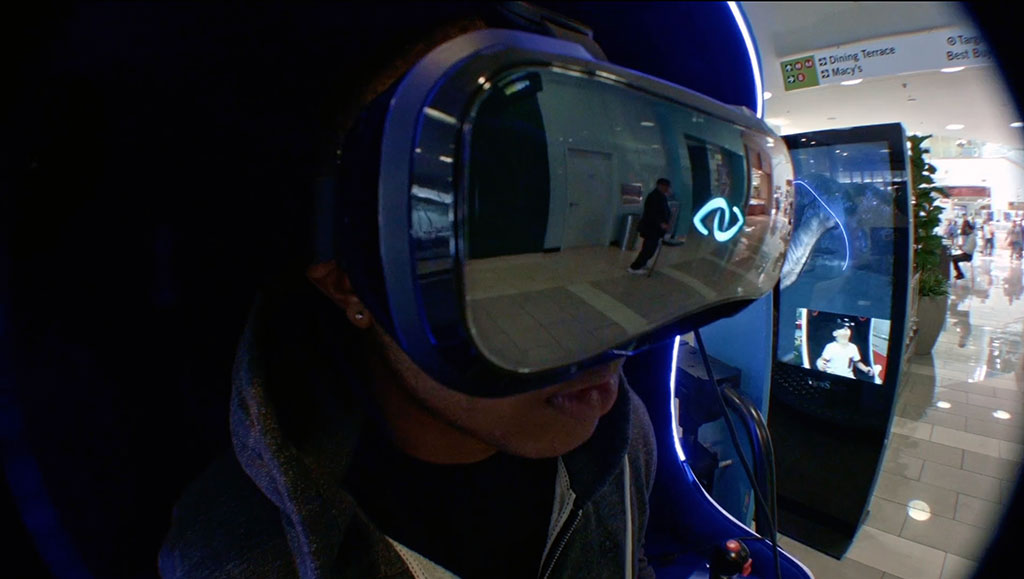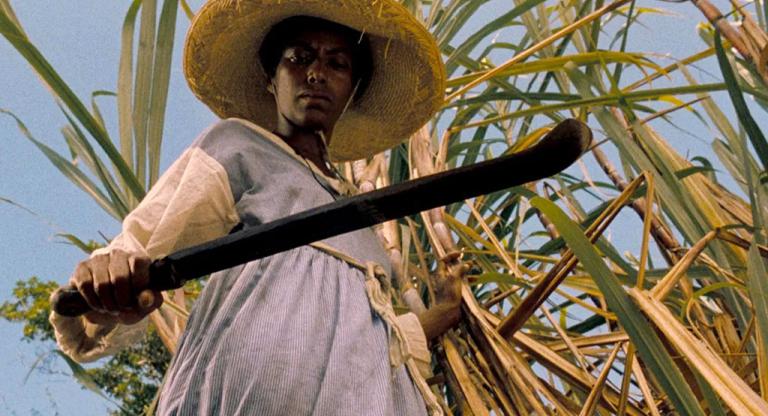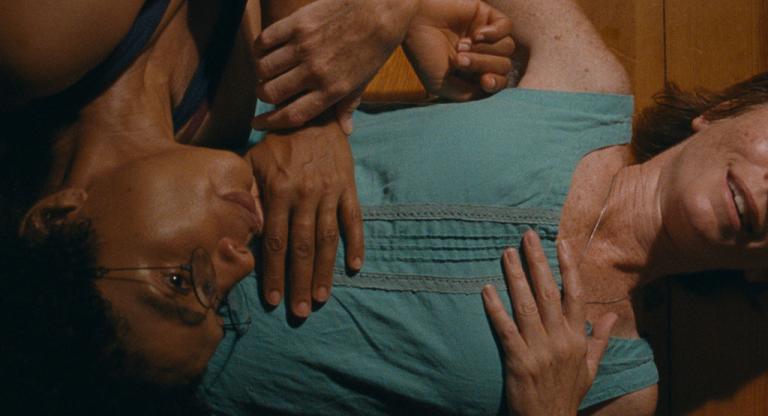The 16mm footage in M. Woods’ feature-length experimental film, Commodity Trading: Dies Irae (2022, pictured above), includes the plum-brown rust of oil refineries, two nude men wearing Trump masks inside a cluttered and cave-like apartment, and the neon lights of Rick Caruso’s The Americana mall in Glendale, Los Angeles, being manipulated into the shape of an eye. Commodity Trading: Dies Irae provokes, amuses, and assaults viewers with a frenetic series of images edited into a palindromic film. The film is not constituted by discrete scenes, but rather a digitally expressionistic blur of movement and sensation. The closest semblance of a plot is a man’s manic odyssey around Los Angeles, which culminates in a virtual reality experience at a Culver City mall. Woods conjures a sense of hyperreality by layering a barrage of effects—extreme fisheye, blurs, animation—to create images that feel hyper-mediated. The film captures the fleeting thrills of digital life, mirroring the experience of someone feverishly doomscrolling through a TikTok feed full of bright colors and scenes of violence—a burning dollar bill bathed in red light cuts to a TV segment on George Floyd protests, which cuts to an overlaid black-and-white image of a Black woman’s face over a burning car, to a fisheye clip of a man in a Donald Trump mask and Mickey Mouse ears pointing a gun at the camera.
Intertitles and news footage anchor the viewer between 2016 and 2020, summoning the era’s confusion and panic. As a documentary, the film historicizes and preserves site- and time-specific feelings through sensory overload. The title, referencing the 13th-century Latin poem "Dies Irae" (translation: Day of Wrath) invokes themes of judgment and hopelessness. But one can’t help but wonder how seriously Woods takes that sense of despair— is the doom and gloom in earnest, or is it just another titillating aspect of his assaultive film? The film’s surreal and cartoonish visuals intentionally keep its overwhelming imagery from feeling too zealous or angry. Woods’s invocation of the“Numb Spiral”—a concept he has explored in other visual work and which he defines as “the results of a digital sickness that manifests itself in the codification and symbolic negation of being”—underscores the pervasive sense of detachment cultivated throughout the film. Among the phosphorescent mess, a dimly lit clip of a raw chicken breast searing in a pan stands out, stripped of context and meaning but startling in its glistening sensuality.
If Commodity Trading: Dies Irae evokes an immersive and hallucinatory carnival, the short film Guillotine (2020) conjures the sensation of walking down a dark corridor and peering into disparate rooms, each revealing distinctive characters and scenes. In Guillotine, Chicago-based filmmaker Sonnie Wooden employs a meticulously curated carousel of social media videos and clips to delve into racially focused realities through genre elements. Wooden includes an unsettling sorority recruitment video, where a sea of young Caucasian women in perfect unison chant and clap in a vaguely pagan pyramid formation. The robotic quality of their smiles and voices wouldn’t be out of place in a Jordan Peele horror film. Guillotine also includes front-facing confessional videos from both victims and perpetrators of racism; in turn, creating a provocative exploration of contemporary race dynamics in the U.S. Taken together, the two films paint a portrait of a highly specific contemporary psychological landscape that has emerged in the American collective experience—yes, nightmarish, but worthy of being mined, ruminated on, and exploited for perverse enjoyment.
Commodity Trading: Dies Irae and Guillotine screen this evening, June 27, at the Maysles Documentary Center. M. Woods will be in attendance for a Q&A.






